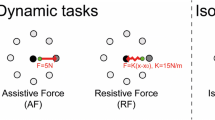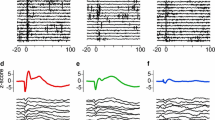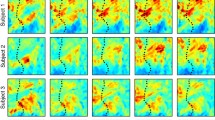Summary
Monkey motor cortex cells were recorded during isolated, isometric contractions of each of four representative arm muscles — a flexor and extensor of wrist and elbow — and comparable response averages computed. Most cells were coactivated with several of the muscles; some fired the same way with all four and others with none. Results suggest that many precentral cells have a higher order relation to muscles than motoneurons.
Operantly reinforced bursts of cell activity were associated with coactivation of specific muscles, called the cell's “motor field”; the most strongly coactivated muscle was usually the one whose isolated contraction had evoked the most intense unit activity. During active elbow movements most cells fired in a manner consistent with their isometric patterns, but clear exceptions were noted. Differential reinforcement of unit activity and muscle suppression was invariably successful in dissociating correlations.
The strength of each unit-muscle correlation was assessed by the relative intensity of their coactivation and its consistency under different response conditions. Several cells exhibited the most intense coactivation with the same muscle during all conditions. Thus, intensity and consistency criteria usually agreed, suggesting that strong correlations so determined may operationally define a “functional relation”.
However, correlations in the sense of covariation are neither necessary nor sufficient evidence to establish anatomical connections. To test the possibility of direct excitatory connections we stimulated the cortex, but found lowest threshold responses in distal muscles, even from points where most cells had been strongly correlated with proximal muscles. Post-spike averages of rectified EMG activity provided scant evidence for cell-related fluctuations in firing probabilities of any muscles.
Similar content being viewed by others
References
Albe-Fessard D., Liebeskind, J.: Origine des messages somatosensitifs activant les cellules du cortex moteur chez le singe. Exp. Brain Res. 1, 127–146 (1966)
Asanuma, H., Rosén, I.: Topographical organization of cortical efferent zones projecting to distal forelimb muscles in the monkey. Exp. Brain Res. 14, 243–256 (1972)
Basmajian, J.V.: Muscles alive. Baltimore: Williams & Wilkins 1973
Chang, H.T., Ruch, T.C., Ward, A.A., Jr.: Topographical representation of muscles in motor cortex of monkeys. J. Neurophysiol. 10, 39–56 (1947)
Clough, J.F.M., Kernell, D., Phillips, C.G.: The distribution of monosynaptic excitation from the pyramidal tract and from primary spindle afferents to motoneurons of the baboon's hand and forearm. J. Physiol. (Lond.) 198, 145–166 (1968)
Evarts, E.V.: Pyramidal tract activity associated with a conditioned hand movement in the monkey. J. Neurophysiol. 29, 1011–1027 (1966)
Evarts, E.V.: Representation of movements and muscles by pyramidal tract neurons of the precentral motor cortex. In: Neurophysiological basis of normal and abnormal motor control. (Ed. by Yahr and Purpura). Hewlett, N.Y.: Raven 1967
Evarts, E.V.: Relation of pyramidal tract activity to force exerted during voluntary move ment. J. Neurophysiol. 31, 14–27 (1968)
Fetz, E.E.: Operant conditioning of cortical unit activity. Science 163, 955–957 (1969)
Fetz, E.E.: Operant control of single unit activity and correlated motor responses. In: Operant control of brain activity. (Ed. by Chase), pp. 61–90. Los Angeles: UCLA Press 1974
Fetz, E.E., Baker, M.A.: Response properties of precentral neurons in awake monkeys Physiologist 12, 223 (1969)
Fetz, E.E., Baker, M.A.: Operantly conditioned patterns of precentral unit activity and correlated responses in adjacent cells and contralateral muscles. J. Neurophysiol. 36, 179–204 (1973)
Fetz, E.E., Finocchio, D.V.: Operant conditioning of specific patterns of neural and muscular activity. Science 174, 431–435 (1971)
Goldring, S., Ratcheson, R.: Human motor cortex: sensory input data from single neuron recording. Science 175, 1493–1495 (1972)
Humphrey, D.R., Schmidt, E.M., Thompson, W.D.: Predicting measures of motor perfor mance from multiple cortical spike trains. Science 170, 758–762 (1970)
Kuypers, H.G.J.M.: Central connections to the motor and somatosensory cell groups. An experimental study in the rhesus monkey. Brain 83, 161–184 (1960)
Landgren, S., Phillips, C.G., Porter, R.: Minimal synaptic actions of pyramidal impulses on some alpha motoneurons of the baboon's hand and forearm. J. Physiol. (Lond.) 161, 91–111 (1962)
Luschei, E.S., Garthwaite, C.R., Armstrong, M.E.: Relationship of firing patterns of units in face area of monkey precentral cortex to conditioned jaw movements. J. Neurophysiol. 34, 552–561 (1971)
Mendell, L.M., Henneman, E.: Terminals of single Ia fibers: location, density and distribution within a pool of 300 homonymous motoneurons. J. Neurophysiol. 34, 171–187 (1971)
Phillips, C.G., Porter, R.: The pyramidal projection to motoneurons of some muscle groups of the baboon's forelimb. In: Physiology of spinal neurons. (Ed. by Eccles and Schadé). Amsterdam: Elsevier 1964
Porter, R., Hore, J.: Time course of minimal corticomotoneuronal excitatory postsynaptic potentials in lumbar motoneurons of the monkey. J. Neurophysiol. 32, 443–451 (1969)
Preston, J.B., Whitlock, D.G.: Intracellular potentials recorded from motoneurons following precentral gyrus stimulation in primates. J. Neurophysiol. 24, 91–100 (1961)
Rosén, I., Asanuma, H.: Peripheral afferent inputs to the forelimb area of the monkey motor cortex: input-output relations. Exp. Brain Res. 14, 257–273 (1972)
Woody, C.D., Black-Cleworth, P.: Differences in excitability of cortical neurons as a function of motor projection in conditioned cats. J. Neurophysiol. 36, 1104–1116 (1973)
Woolsey, C.N., Settlage, P.H., Meyer, D.R., Spencer, W., Pinto Hamuy, T., Travis, A.M.: Patterns of localization in precentral and “supplementary” motor areas and their relation to the concepts of a premotor area. Res. Publ. Ass. nerv. ment. Dis. 30, 238–264 (1951)
Author information
Authors and Affiliations
Rights and permissions
About this article
Cite this article
Fetz, E.E., Finocchio, D.V. Correlations between activity of motor cortex cells and arm muscles during operantly conditioned response patterns. Exp Brain Res 23, 217–240 (1975). https://doi.org/10.1007/BF00239736
Received:
Issue Date:
DOI: https://doi.org/10.1007/BF00239736




